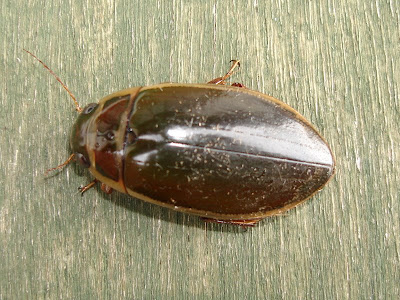 Weather conditions through the night of 30th March were ideal for moth activity as there was good cloud cover and no wind. The moth trap was put on in the country park and about 120 moths of 12 species seemed a reasonable amount for the time of year.
Weather conditions through the night of 30th March were ideal for moth activity as there was good cloud cover and no wind. The moth trap was put on in the country park and about 120 moths of 12 species seemed a reasonable amount for the time of year.The most eye-catching moth was this herald moth pictured above with its orange patches on the wings and the distinctive jagged ends to the wings. Only one herald was seen last year and that was in mid July.
 There were several of these blossom underwing moths in the trap as well as lots of the common quaker, hebrew character, small quaker and March moths.
There were several of these blossom underwing moths in the trap as well as lots of the common quaker, hebrew character, small quaker and March moths. There were two shoulder stripe moths, this one pictured above and also a very dark individual. Other moths found were satellite, nutmeg, clouded drab and a dark chestnut.
There were two shoulder stripe moths, this one pictured above and also a very dark individual. Other moths found were satellite, nutmeg, clouded drab and a dark chestnut.During the day a small white butterfly was seen near the car park, which is the first sighting at the park this year. A visitor to the park reported seeing 4 adders late in the morning.
No new summer migrants to report from the park with the pond chiffchaff still singing loudly. There was a brief glimpse of a martin / swallow flashing across the car park but it didn't provide a good enough view to tell which one it was. It was nice to see a pair of linnets after the winter near the cliff-top and in the afternoon two siskins flew over the park.
The still mild conditions were ideal for listening to several singing skylarks high above the park, whilst down below a couple of meadow pipits sang. In the grazing fields there was a pair of greylag geese and Canada geese, whilst along the dyke one of the swans was sitting on its nest and 2 pairs of little grebe squabbled with each other.
A visit to the Reeveshall pool for the last hour of daylight provided views of 1000 brent geese still wintering on the Island, feeding on the nearby pasture as well as several scattered pairs of greylags and Canada geese. On the pool there were a few wigeon, teal, mallard, shelduck, pair of mute swans and 5 black-tailed godwits. A bright male yellowhammer was seen last thing along the usual ditch. In the big grass field 7 brown hares came to life at dusk.
In the Pyefleet there were 8 red-breasted mergansers and 7 great crested grebes as well as the usual waers along the mudflats. On Langenhoe there were about 7 marsh harriers seen over the Point reedbed.























